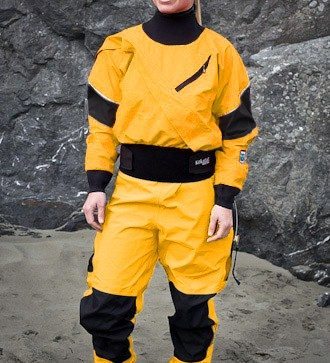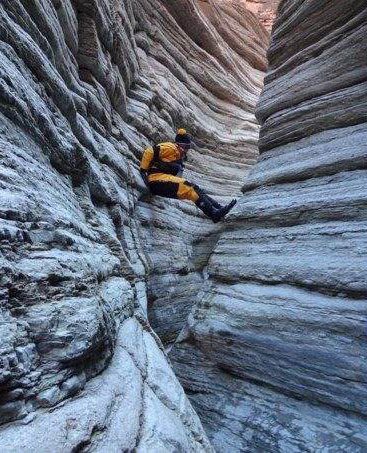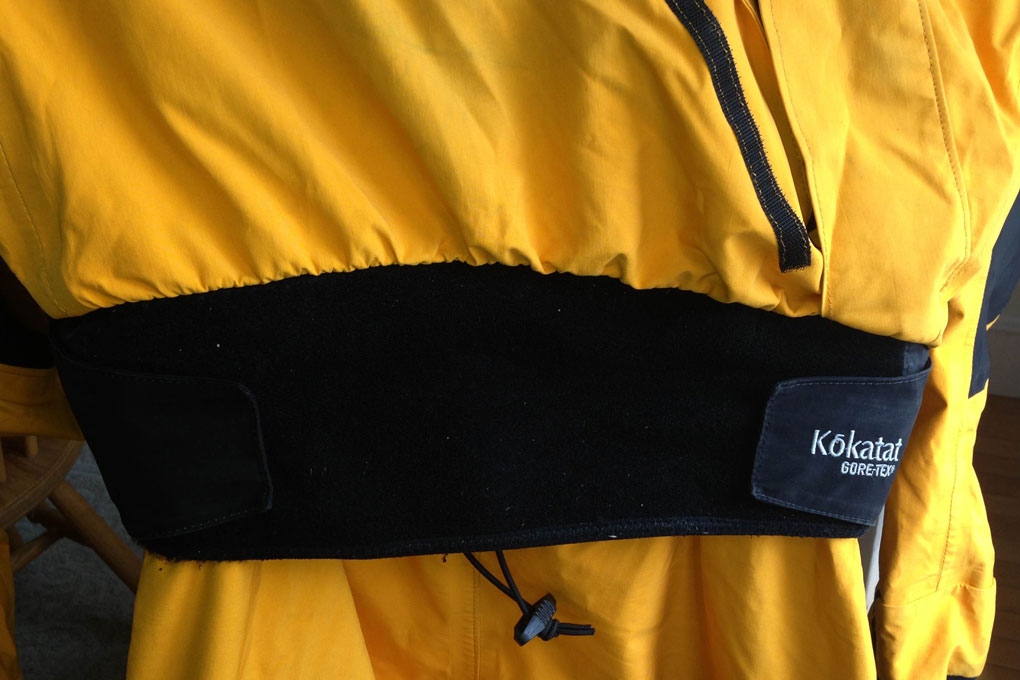 Kokatat Gore-Tex Meridian Women’s Dry Suit with Drop Seat & Socks
Kokatat Gore-Tex Meridian Women’s Dry Suit with Drop Seat & Socks
Reviewer: 5’10”, 175 lbs.
Size Reviewed: Large
Technical Info from the Manufacturer:
- Evolution 3.21 oz. nylon 3-layer GORE-TEX®
- Self draining punch-through neck & wrist neoprene over-cuffs
- Latex gaskets
- Self draining, zippered chest pocket with key lanyard
- Competition cut underarm
- Covered metal tooth, waterproof Optiseal chest zipper
- Dual-adjustable overskirt incorporates “hook & loop” compatible neoprene
- Adjustable bungee drawcord at waist
- Cordura® seat and knee patches, self-draining
- “Hook & loop” adjustable neoprene over-cuffs at ankle
- Factory sealed seams
- Drop seat
- GORE-TEX® socks
Test Locations: The Grand Canyon; Maine creeks, playspots and rivers
Days worn: ~30
MSRP: $1,070
Kokatat calls the Meridian its most popular women’s dry suit, and it is generally regarded by the whitewater community to be the toughest and driest suit on the market. It has all the bells and whistles a kayaker could want to stay warm, dry, and comfortable during a cold day on the river, and, for the price, one would hope that it would.
First of all, it is the only US-made dry suit that I have been able to find with a drop seat. (Palm, a British company, makes one, but it is difficult to find a retailer in the US that sells them.) It also features a Gore-Tex body and booties, front-entry zipper, reinforced seat and knees, a tunnel, reflective piping along the back and shoulders, and neoprene overcuffs.
Body

The Gore-Tex body of the Meridian does not seem as though it is going to rip or wear easily, and the Cordura-reinforced rear and knee patches increase its overall durability. Not only do these areas see the most contact with your boat, they are also the areas most likely to get a little abused while clambering over rocks to scout drops or while hiking in to rivers.
Fully taped “factory sealed” seams keep water from seeping through the cracks not only when kayaking but when side adventures might involve some deep wading, or even swimming.
The reputable Gore Tex name is certainly reflected in the price of this suit, and so far I am happy with the Gore Tex’s performance. That said, this past January, Kokatat unveiled their waterproof / breathable Hydrus 3L fabric (the next generation of what was their T3 material) and now sell a Meridian dry suit essentially identical to the Gore-Tex one, but made with Hydrus 3L. I have not had a chance to compare the two, but the Hydrus 3L Meridian dry suit does sell for a few hundred dollars less (MSRP $800). To be honest, now that it is available, I would likely go with the Hydrus Meridian rather than pay for the Gore Tex name, since the reports I’ve heard say that they are pretty comparable.
No matter how breathable a fabric is, however, there is always a certain amount of stuffiness that occurs when you’re zipped into a waterproof suit and you start exerting yourself. But I run pretty warm, and I have found that I was mostly comfortable in the Gore Tex Meridian on strenuous Grand Canyon side hikes that were not long enough to necessitate a full delayer, or on tricky portages that prompt perspiration.
Tunnel
The tunnel of the Meridian fits nicely over my spray skirt (Snap Dragon White Water Armortex EXP) to keep unnecessary water out of my cockpit. The upper portion provides easy access to the front zipper through a slit that is protected by an overflap held closed with “hook and loop closure” (essentially Velcro, for those of us who are not fluent in Kokatat technical language). The lower neoprene section tightens snugly over my spray skirt tunnel also with “hook and loop closure” tabs that tighten the neoprene around your waist.
Some people prefer the rear-entry suits because they negate the need for a slit in the tunnel to access the front zipper, thereby decreasing the potential for water to enter your cockpit through the tunnel. I have not had the opportunity to compare a front zip to back zip, and some water does still get into my boat (note: my spray skirt tunnel is a little bigger than I would like). But I have heard from fellow boaters that the rear zip keeps out the most water. What I can say with assurance is that this tunnel definitely keeps more water out of my cockpit than did my previous drysuit, which had no tunnel at all. Ultimately, the front zip versus back zip debate comes down to personal preference.
Cuffs, Gaskets, and Booties
The neck and wrist gaskets of the Meridian are all latex and are protected by a self-draining neoprene overcuff. The overcuff tapers off from where it attaches to the sleeve down to the wrist, which fits nicely and is not baggy, something I like quite a lot. There is no fumbling with Velcro to ensure your sleeve doesn’t slide down over your hands as you paddle, as is the case with the majority of cuffs (Bomber Gear and Level Six are the only other brands I have seen that have a similar tapered overcuff). Instead, there’s just a nice streamlined overcuff that fits well under my NRS Maverick gloves (and with a little more fumbling could also fit over).
The neoprene ankle cuff can be tightened with “hook and loop closure” over your river shoe of choice and protect the upper part of the Gore Tex bootie. The Gore Tex (as opposed to latex) bootie on this dry suit is, I think, one of its key features. I have much greater faith in the Gore Tex bootie than latex, which I think has a much higher risk of being punctured or torn.
My previous dry suit (made by Musto and for sailing) had latex booties that lasted about four years (20-30 days of use per year between sailing and kayaking) before they ultimately began to leak and then disintegrate, leaving sticky, gaping holes. While my Gore Tex booties have not yet lived the years of my previous ones, I feel better knowing they are tougher material that shouldn’t disintegrate and thus provide me with a higher probability of dry feet. Furthermore they are simply so much easier to slide into a tight shoe or bootie.

